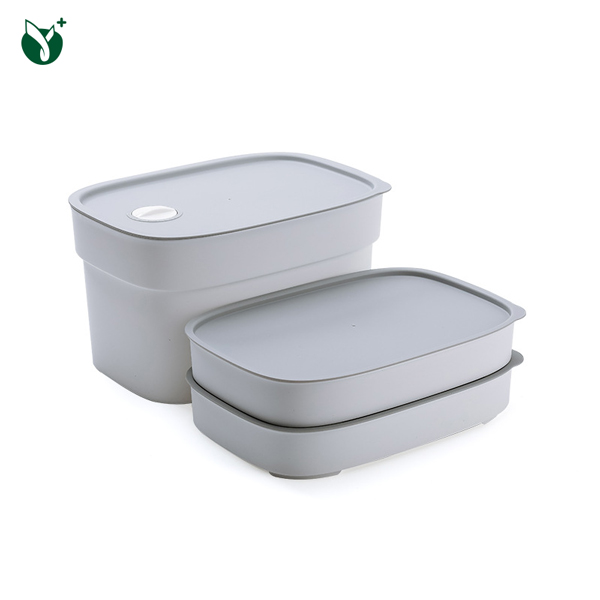
In a world increasingly focused on sustainability and environmental responsibility, the demand for biodegradable materials has never been greater. Addressing this urgent need, a leading company specializing in the development of eco-friendly products has successfully launched a new generation of PLA lunch boxes. This innovation embodies the company’s commitment to sustainable development and marks a significant step forward in the field of biodegradable materials.
### Pioneering Sustainable Packaging
With a research and development team boasting extensive experience in biodegradable materials, the company has dedicated itself to crafting solutions that reduce environmental impact without compromising functionality. The PLA lunch box is the latest milestone in this journey, designed to cater to consumers and businesses seeking reliable, eco-friendly alternatives to conventional plastic packaging.
PLA, or polylactic acid, is a biodegradable polymer derived from renewable resources such as corn starch or sugarcane. Unlike traditional plastics that persist in the environment for hundreds of years, PLA decomposes naturally under industrial composting conditions, breaking down into harmless organic compounds. This attribute positions PLA as an ideal candidate for single-use food containers, which have historically been a major contributor to plastic waste pollution.
### Expertise and Collaboration Fuel Innovation
The company’s success in launching the PLA lunch box is fueled by the strength of its R&D team, which combines deep industry knowledge with cutting-edge technological expertise. The team has spent years refining formulations and manufacturing processes to enhance the durability, heat resistance, and biodegradability of PLA products. They have also focused on optimizing production methods to ensure scalability and cost-effectiveness, critical factors for widespread adoption.
Central to this innovation is a strategic partnership with the School of Materials Science and Chemical Engineering at Ningbo University. This academic collaboration enables a seamless integration of theoretical research and practical application. By sharing expertise and resources, the company and the university are collectively pushing the boundaries of material science to develop new-generation biodegradable products.
Professor Zhang Wei, a leading researcher at Ningbo University, highlighted the importance of this alliance: “Combining academic research with industrial capabilities accelerates the development of environmentally friendly materials that meet modern market demands. This cooperation exemplifies how science and industry can join forces to create sustainable solutions that benefit society.”
### Opening a New Era of Environmental-Friendly Materials
The launch of the PLA lunch box signifies more than just a new product on the market; it ushers in a new era in the environmental-friendly materials sector. It demonstrates how innovation can be harnessed to address ecological challenges while fulfilling consumer expectations for quality and convenience.
With plastic pollution reaching critical levels worldwide, governments and industries are under increasing pressure to adopt sustainable packaging solutions. The PLA lunch box offers a practical alternative that aligns with global regulatory trends targeting single-use plastics. By replacing traditional plastic lunch boxes with biodegradable PLA variants, businesses—especially in the foodservice sector—can significantly reduce their carbon footprint and environmental impact.
Moreover, the company’s commitment to continuous improvement ensures that they will soon expand their product range to encompass other biodegradable packaging options and materials. This broad-based approach is essential for creating a circular economy where waste is minimized, and resources are efficiently reused or safely decomposed.
### Benefits Beyond Environmental Protection
While environmental sustainability is the primary driver, the new PLA lunch box also offers numerous consumer benefits. It is lightweight, sturdy, and microwave-safe, making it suitable for diverse food storage and transportation needs. The material is also odorless and non-toxic, ensuring food safety and maintaining the integrity of meals.
From a business perspective, incorporating biodegradable lunch boxes enables companies to elevate their brand image by showcasing a genuine commitment to sustainability. This can improve customer loyalty and meet the growing consumer demand for responsible practices.
### Looking Ahead
The company’s collaboration with Ningbo University is set to continue producing innovative materials that blend environmental responsibility with high performance. Future research focuses include enhancing biodegradability under varying environmental conditions, improving material properties, and reducing costs.
As awareness and legislation around plastic waste grow, products like the PLA lunch box stand at the forefront of environmentally responsible living. They represent a tangible step toward the global goal of reducing plastic pollution and conserving natural resources for future generations.
### Conclusion
The introduction of the new PLA lunch box highlights how experienced R&D teams, supported by strong academic partnerships, can pioneer sustainable products that meet the needs of today’s eco-conscious consumers. This launch not only provides a practical solution for reducing plastic waste but also exemplifies an exciting shift towards a more sustainable future through innovation in biodegradable materials.
By embracing biodegradable packaging, businesses and consumers alike play an active role in protecting the planet. This milestone expands the possibilities for environmental-friendly materials and sets a benchmark for responsible manufacturing and consumption in the years to come.
